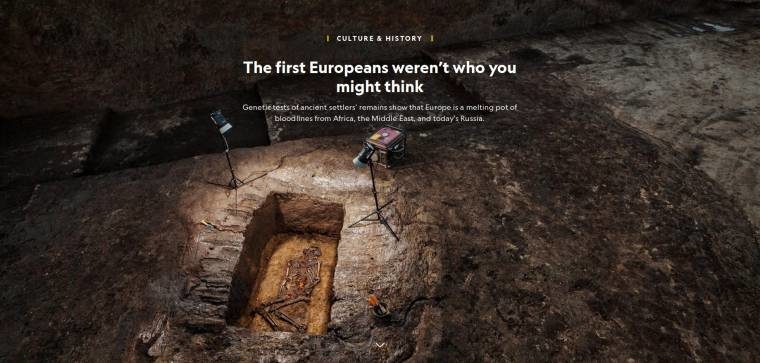
Now scientists are delivering new answers to the question of who Europeans really are and where they came from. Their findings suggest that the continent has been a melting pot since the Ice Age. Europeans living today, in whatever country, are a varying mix of ancient bloodlines hailing from Africa, the Middle East, and the Russian steppe.
The evidence comes from archaeological artifacts, from the analysis of ancient teeth and bones, and from linguistics. But above all it comes from the new field of paleogenetics. During the past decade it has become possible to sequence the entire genome of humans who lived tens of millennia ago. Technical advances in just the past few years have made it cheap and efficient to do so; a well-preserved bit of skeleton can now be sequenced for around $500.
The result has been an explosion of new information that is transforming archaeology. In 2018 alone, the genomes of more than a thousand prehistoric humans were determined, mostly from bones dug up years ago and preserved in museums and archaeological labs. In the process any notion of European genetic purity has been swept away on a tide of powdered bone.
Analysis of ancient genomes provides the equivalent of the personal DNA testing kits available today, but for people who died long before humans invented writing, the wheel, or pottery. The genetic information is startlingly complete: Everything from hair and eye color to the inability to digest milk can be determined from a thousandth of an ounce of bone or tooth. And like personal DNA tests, the results reveal clues to the identities and origins of ancient humans' ancestors — and thus to ancient migrations.
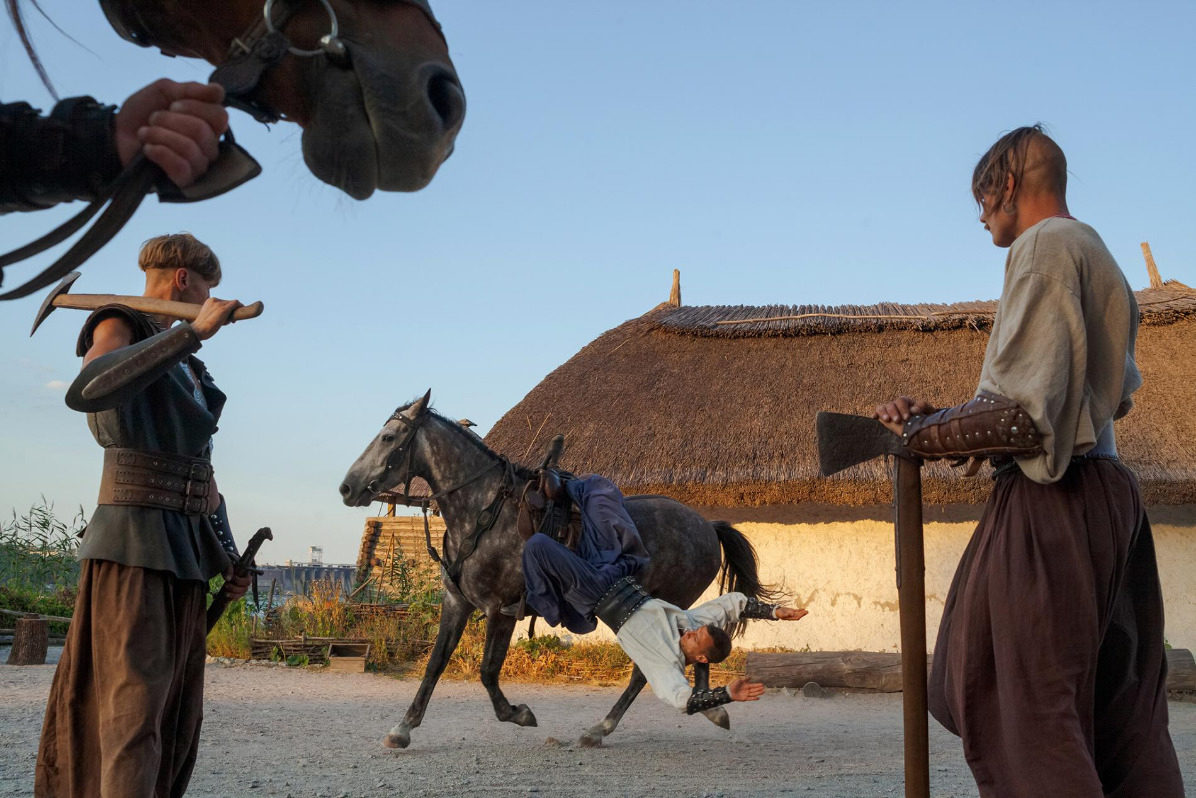
In an era of debate over migration and borders, the science shows that Europe is a continent of immigrants and always has been. "The people who live in a place today are not the descendants of people who lived there long ago," says Harvard University paleogeneticist David Reich. "There are no indigenous people — anyone who hearkens back to racial purity is confronted with the meaninglessness of the concept."



First wave: Out of Africa
Thirty-two years ago the study of the DNA of living humans helped establish that we all share a family tree and a primordial migration story: All people outside Africa are descended from ancestors who left that continent more than 60,000 years ago. About 45,000 years ago, those first modern humans ventured into Europe, having made their way up through the Middle East. Their own DNA suggests they had dark skin and perhaps light eyes.
Comment: The Out Of Africa theory has been discredited: Previously unknown "proto-hominin" species suggests ancestor of humans evolved in Europe not Africa
Europe then was a forbidding place. Mile-thick ice sheets covered parts of the continent. Where there was enough warmth, there was wildlife. There were also other humans, but not like us: Neanderthals, whose own ancestors had wandered out of Africa hundreds of thousands of years earlier, had already adapted to the cold and harsh conditions.
Comment: There's evidence that suggests the area was much more comfortable: 1 million year old hyena fossils discovered in the Arctic
The first modern Europeans lived as hunters and gatherers in small, nomadic bands. They followed the rivers, edging along the Danube from its mouth on the Black Sea deep into western and central Europe. For millennia, they made little impact. Their DNA indicates they mixed with the Neanderthals — who, within 5,000 years, were gone. Today about 2 percent of a typical European's genome consists of Neanderthal DNA. A typical African has none.
As Europe was gripped by the Ice Age, the modern humans hung on in the ice-free south, adapting to the cold climate. Around 27,000 years ago, there may have been as few as a thousand of them, according to some population estimates. They subsisted on large mammals such as mammoths, horses, reindeer, and aurochs — the ancestors of modern cattle. In the caves where they sheltered, they left behind spectacular paintings and engravings of their prey.
You can see the full size version here.
About 14,500 years ago, as Europe began to warm, humans followed the retreating glaciers north. In the ensuing millennia, they developed more sophisticated stone tools and settled in small villages. Archaeologists call this period the Mesolithic, or Middle Stone Age.
Comment: And yet Neanderthals were crafting jewellery at least 68,000 years ago, while 50,000 years ago Denisovans are suspected to have made a "tiara".
In the 1960s Serbian archaeologists uncovered a Mesolithic fishing village nestled in steep cliffs on a bend of the Danube, near one of the river's narrowest points. Called Lepenski Vir, the site was an elaborate settlement that had housed as many as a hundred people, starting roughly 9,000 years ago. Some dwellings were furnished with carved sculptures that were half human, half fish.
Bones found at Lepenski Vir indicated that the people there depended heavily on fish from the river. Today what remains of the village is preserved under a canopy overlooking the Danube; sculptures of goggle-eyed river gods still watch over ancient hearths. "Seventy percent of their diet was fish," says Vladimir Nojkovic, the site's director. "They lived here almost 2,000 years, until farmers pushed them out."
Comment: Much like in Scandinavia: Scandinavian Stone Age society more reliant on fishing than previously thought - particularly aquatic mammals
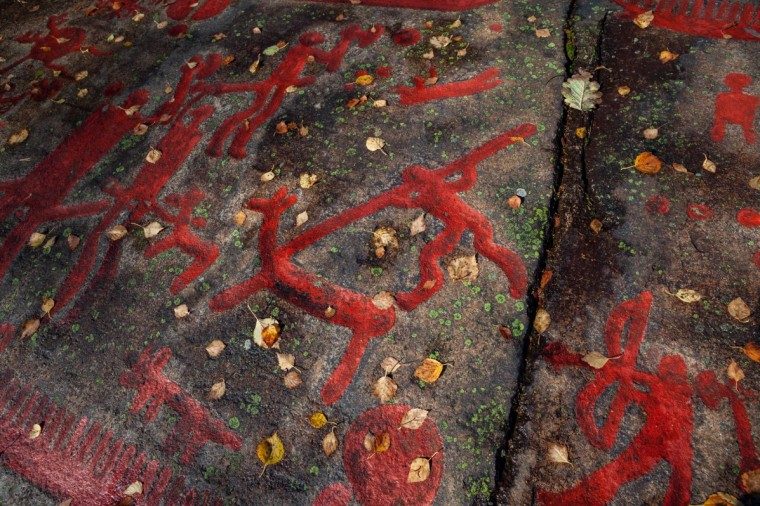

The Konya Plain in central Anatolia is modern Turkey's breadbasket, a fertile expanse where you can see rainstorms blotting out mountains on the horizon long before they begin spattering the dust around you. It has been home to farmers, says University of Liverpool archaeologist Douglas Baird, since the first days of farming. For more than a decade Baird has been excavating a prehistoric village here called Boncuklu. It's a place where people began planting small plots of emmer and einkorn, two ancient forms of wheat, and probably herding small flocks of sheep and goats, some 10,300 years ago, near the dawn of the Neolithic period.
Comment: Notably, this is the period that (at least part of) Gobekli Tepe is believed to have been constructed: Ancient carvings on Gobekli pillar show evidence of a comet swarm hitting Earth around 13,000 years ago
Within a thousand years the Neolithic revolution, as it's called, spread north through Anatolia and into southeastern Europe. By about 6,000 years ago, there were farmers and herders all across Europe.
It has long been clear that Europe acquired the practice of farming from Turkey or the Levant, but did it acquire farmers from the same places? The answer isn't obvious. For decades, many archaeologists thought a whole suite of innovations — farming, but also ceramic pottery, polished stone axes capable of clearing forests, and complicated settlements — was carried into Europe not by migrants but by trade and word of mouth, from one valley to the next, as hunter-gatherers who already lived there adopted the new tools and way of life.
But DNA evidence from Boncuklu has helped show that migration had a lot more to do with it. The farmers of Boncuklu kept their dead close, burying them in the fetal position under the floors of their houses. Beginning in 2014, Baird sent samples of DNA extracted from skull fragments and teeth from more than a dozen burials to DNA labs in Sweden, Turkey, the U.K., and Germany.
Many of the samples were too badly degraded after spending millennia in the heat of the Konya Plain to yield much DNA. But then Johannes Krause and his team at Germany's Max Planck Institute for the Science of Human History tested the samples from a handful of petrous bones. The petrous bone is a tiny part of the inner ear, not much bigger than a pinkie tip; it's also about the densest bone in the body. Researchers have found that it preserves genetic information long after usable DNA has been baked out of the rest of a skeleton. That realization, along with better sequencing machines, has helped drive the explosion in ancient DNA studies.

They didn't stop in southeastern Europe. Over the centuries their descendants pushed along the Danube past Lepenski Vir and deep into the heart of the continent. Others traveled along the Mediterranean by boat, colonizing islands such as Sardinia and Sicily and settling southern Europe as far as Portugal. From Boncuklu to Britain, the Anatolian genetic signature is found wherever farming first appears.
Those Neolithic farmers mostly had light skin and dark eyes — the opposite of many of the hunter-gatherers with whom they now lived side by side. "They looked different, spoke different languages ... had different diets," says Hartwick College archaeologist David Anthony. "For the most part, they stayed separate."
Comment: It would appear that these different diets were inferior: Çatalhöyük: The 9,000 year old community troubled by climate change, over crowding and infectious diseases
Across Europe, this creeping first contact was standoffish, sometimes for centuries. There's little evidence of one group taking up the tools or traditions of the other. Even where the two populations did mingle, intermarriage was rare. "There's no question they were in contact with each other, but they weren't exchanging wives or husbands," Anthony says. "Defying every anthropology course, people were not having sex with each other." Fear of the other has a long history.
About 5,400 years ago, everything changed. All across Europe, thriving Neolithic settlements shrank or disappeared altogether. The dramatic decline has puzzled archaeologists for decades. "There's less stuff, less material, less people, less sites," Krause says. "Without some major event, it's hard to explain." But there's no sign of mass conflict or war.
After a 500-year gap, the population seemed to grow again, but something was very different. In southeastern Europe, the villages and egalitarian cemeteries of the Neolithic were replaced by imposing grave mounds covering lone adult men. Farther north, from Russia to the Rhine, a new culture sprang up, called Corded Ware after its pottery, which was decorated by pressing string into wet clay.
The State Museum of Prehistory in Halle, Germany, has dozens of Corded Ware graves, including many that were hastily rescued by archaeologists before construction crews went to work. To save time and preserve delicate remains, the graves were removed from the ground in wooden crates, soil and all, and stored in a warehouse for later analysis. Stacked to the ceiling on steel shelves, they're now a rich resource for geneticists.

When researchers first analyzed the DNA from some of these graves, they expected the Corded Ware folk would be closely related to Neolithic farmers. Instead, their DNA contained distinctive genes that were new to Europe at the time — but are detectable now in just about every modern European population. Many Corded Ware people turned out to be more closely related to Native Americans than to Neolithic European farmers. That deepened the mystery of who they were.

One bright October Morning near the Serbian town of Žabalj, Polish archaeologist Piotr Włodarczak and his colleagues steer their pickup toward a mound erected 4,700 years ago. On the plains flanking the Danube, mounds like this one, a hundred feet across and 10 feet high, provide the only topography. It would have taken weeks or months for prehistoric humans to build each one. It took Włodarczak's team weeks of digging with a backhoe and shovels to remove the top of the mound.
Standing on it now, he peels back a tarp to reveal what's underneath: a rectangular chamber containing the skeleton of a chieftain, lying on his back with his knees bent. Impressions from the reed mats and wood beams that formed the roof of his tomb are still clear in the dark, hard-packed earth.
"It's a change of burial customs around 2800 B.C.," Włodarczak says, crouching over the skeleton. "People erected mounds on a massive scale, accenting the individuality of people, accenting the role of men, accenting weapons. That's something new in Europe."
It was not new 800 miles to the east, however. On what are now the steppes of southern Russia and eastern Ukraine, a group of nomads called the Yamnaya, some of the first people in the world to ride horses, had mastered the wheel and were building wagons and following herds of cattle across the grasslands. They built few permanent settlements. But they buried their most prominent men with bronze and silver ornaments in mighty grave mounds that still dot the steppes.
By 2800 B.C, archaeological excavations show, the Yamnaya had begun moving west, probably looking for greener pastures. Włodarczak's mound near Žabalj is the westernmost Yamnaya grave found so far. But genetic evidence, Reich and others say, shows that many Corded Ware people were, to a large extent, their descendants. Like those Corded Ware skeletons, the Yamnaya shared distant kinship with Native Americans — whose ancestors hailed from farther east, in Siberia.
Within a few centuries, other people with a significant amount of Yamnaya DNA had spread as far as the British Isles. In Britain and some other places, hardly any of the farmers who already lived in Europe survived the onslaught from the east. In what is now Germany, "there's a 70 percent to possibly 100 percent replacement of the local population," Reich says. "Something very dramatic happens 4,500 years ago."
Until then, farmers had been thriving in Europe for millennia. They had settled from Bulgaria all the way to Ireland, often in complex villages that housed hundreds or even thousands of people. Volker Heyd, an archaeologist at the University of Helsinki, Finland, estimates there were as many as seven million people in Europe in 3000 B.C. In Britain, Neolithic people were constructing Stonehenge.
To many archaeologists, the idea that a bunch of nomads could replace such an established civilization within a few centuries has seemed implausible. "How the hell would these pastoral, decentralized groups overthrow grounded Neolithic society, even if they had horses and were good warriors?" asks Kristian Kristiansen, an archaeologist at the University of Gothenburg in Sweden.
A clue comes from the teeth of 101 people living on the steppes and farther west in Europe around the time that the Yamnaya's westward migration began. In seven of the samples, alongside the human DNA, geneticists found the DNA of an early form of Yersinia pestis — the plague microbe that killed roughly half of all Europeans in the 14th century.
Unlike that flea-borne Black Death, this early variant had to be passed from person to person. The steppe nomads apparently had lived with the disease for centuries, perhaps building up immunity or resistance — much as the Europeans who colonized the Americas carried smallpox without succumbing to it wholesale. And just as smallpox and other diseases ravaged Native American populations, the plague, once introduced by the first Yamnaya, might have spread rapidly through crowded Neolithic villages. That could explain both their surprising collapse and the rapid spread of Yamnaya DNA from Russia to Britain.
"Plague epidemics cleared the way for the Yamnaya expansion," says Morten Allentoft, an evolutionary biologist at the Natural History Museum of Denmark, who helped identify the ancient plague DNA.
But that theory has a major question: Evidence of plague has only just recently been documented in ancient Neolithic skeletons, and so far, no one has found anything like the plague pits full of diseased skeletons left behind after the Black Death. If a plague wiped out Europe's Neolithic farmers, it left little trace.
Whether or not they brought plague, the Yamnaya did bring domesticated horses and a mobile lifestyle based on wagons into Stone Age Europe. And in bringing innovative metal weapons and tools, they may have helped nudge Europe toward the Bronze Age.
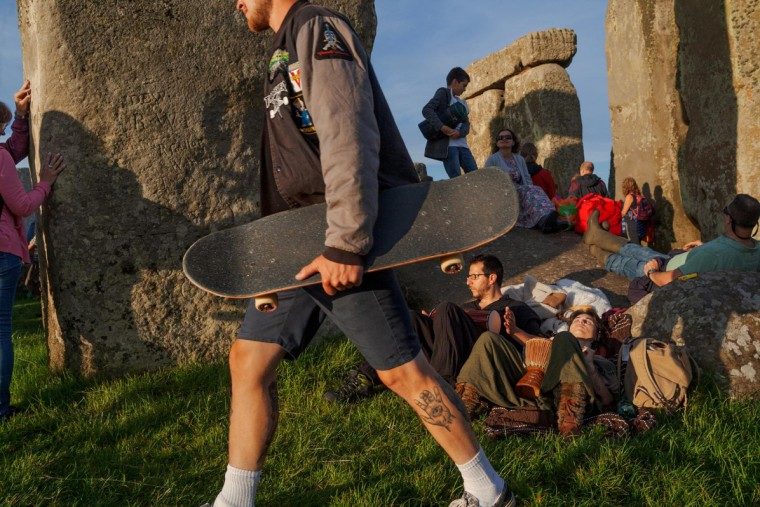
Another theory, proposed a century ago by a German scholar named Gustaf Kossinna, held that the proto-Indo-Europeans were an ancient race of north Germans — the people who made Corded Ware pots and axes. Kossinna thought that the ethnicity of people in the past — their biological identity, in effect — could be deduced from the stuff they left behind.
"Sharply defined archaeological cultural areas," he wrote, "correspond unquestionably with the areas of particular people or tribes."
The north German tribe of proto-Indo-Europeans, Kossinna argued, had moved outward and dominated an area that stretched most of the way to Moscow. Nazi propagandists later used that as an intellectual justification for the modern Aryan "master race" to invade eastern Europe.
Partly as a result, for decades after World War II the whole idea that ancient cultural shifts might be explained by migrations fell into ill repute in some archaeological circles. Even today it makes some archaeologists uncomfortable when geneticists draw bold arrows across maps of Europe.
"This kind of simplicity leads back to Kossinna," says Heyd, who's German. "It calls back old demons of blond, blue-eyed guys coming back somehow out of the hell where they were sent after World War II."
Yet ancient DNA, which provides direct information about the biology of ancient humans, has become a strong argument against Kossinna's theory. First, in documenting the spread of the Yamnaya and their descendants deeper and deeper into Europe at just the right time, the DNA evidence supports the favored theory among linguists: that proto-Indo-Europeans migrated into Europe from the Russian steppe, not the other way around. Second, together with archaeology it amounts to a rejection of Kossinna's claim that some kind of pure race exists in Europe, one that can be identified from its cultural artifacts.
All Europeans today are a mix. The genetic recipe for a typical European would be roughly equal parts Yamnaya and Anatolian farmer, with a much smaller dollop of African hunter-gatherer. But the average conceals large regional variations: more "eastern cowboy" genes in Scandinavia, more farmer ones in Spain and Italy, and significant chunks of hunter-gatherer DNA in the Baltics and eastern Europe.
"To me, the new results from DNA are undermining the nationalist paradigm that we have always lived here and not mixed with other people," Gothenburg's Kristiansen says. "There's no such thing as a Dane or a Swede or a German." Instead, "we're all Russians, all Africans."
From his base in Berlin, Andrew Curry writes about archaeology and other subjects. Rémi Bénali lives near Arles, France, where he photographed a Roman boat for the April 2014 issue.



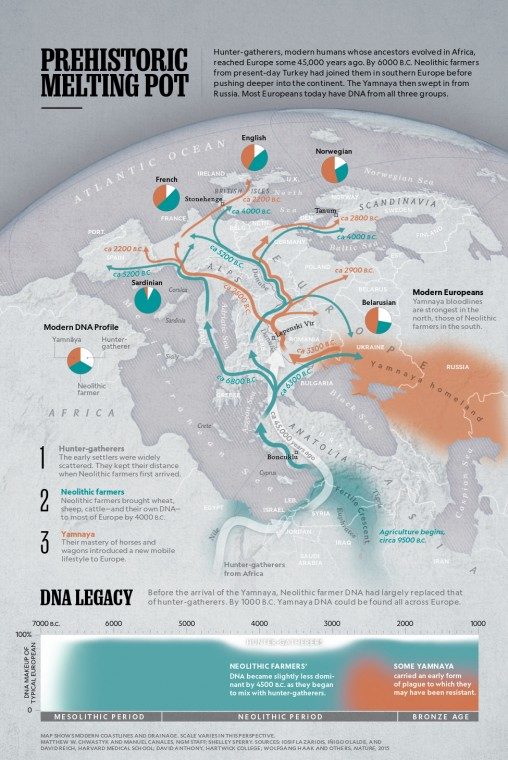




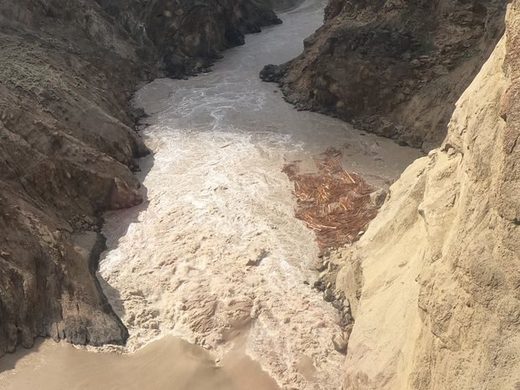



You will see what the original European looked like.
Shalom